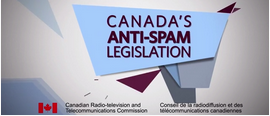I’m writing this on the eve of the implementation of the CASL regulations which come into effect on July 1, 2014.
 Over the past few weeks, I’ve been reading various interpretations of the law and I’ve gone to the Canadian Government website to read the actual Act itself.
Over the past few weeks, I’ve been reading various interpretations of the law and I’ve gone to the Canadian Government website to read the actual Act itself.
Which leads me to say… I am not a lawyer, certainly not a Canadian lawyer, so I’m not in any way qualified to give legal advice. Also, parts of this Act cover marketing channels in which I am also not an expert in so make sure you consult with legal council to make sure you’re covered.
First let me direct you to the Canadian Government website which has the act and various articles and videos to help you through it.
http://www.crtc.gc.ca/eng/casl-lcap.htm
Here’s what I think are some of the highlights.
1. CASL applies to any commercial activity contained in a message. Note we’re not only talking about email messages, but also social media, text, apps, and programs that could contain commercial content. Make sure you don’t limit your scope to reviewing email-only messages.
2. There are 3 new parts to the Act.
– You must have consent to send the message. It defines consent as being express or implied. (more on that later)
– You must clearly identify the sender.
– You must include an unsubscribe mechanism.
3. Certain activities like Forward to a Friend, email appending, and email list purchases now simply fall outside of the consent section and are no longer acceptable.
4. Express consent; if you are using a single or double optin feature, your procedures meet the criteria of express consent. Someone must request to be on your list. It’s up to the sender to prove you have their request. You can also get express consent if you allow someone to check a box to state their express consent but you can no longer have a check box default automatically default to “YES send me messages.”
5. Implied consent; if you have a prior business relationship or a prior non-business relationship, you may have implied consent to send a commercial electronic message. The big difference is the 2 year time limit on implied consent. After that time the implied consent is no longer valid.
You might be starting to get the impression this may impact your email marketing practices and processes if you’re planning to send commercial electronic messages (CEM) in Canada.
And you’d be right.
Here are a few other resources I thought might help you sort through it.
Deloitte: Deloitte, one of Canada’s leading professional services firms, provides audit, tax, consulting, and financial advisory services produced a CASL FAQ on their website.
ClickZ: Marketing News & Expert Advice also provided an impact article.
http://www.clickz.com/clickz/column/2348625/casl-s-impact-on-email-marketers
Like I said earlier. There are some tricky bits to this legislation and some misinformation has already started to surface so make sure you look into it. The fines are steep and can be attached to directors and officers.
